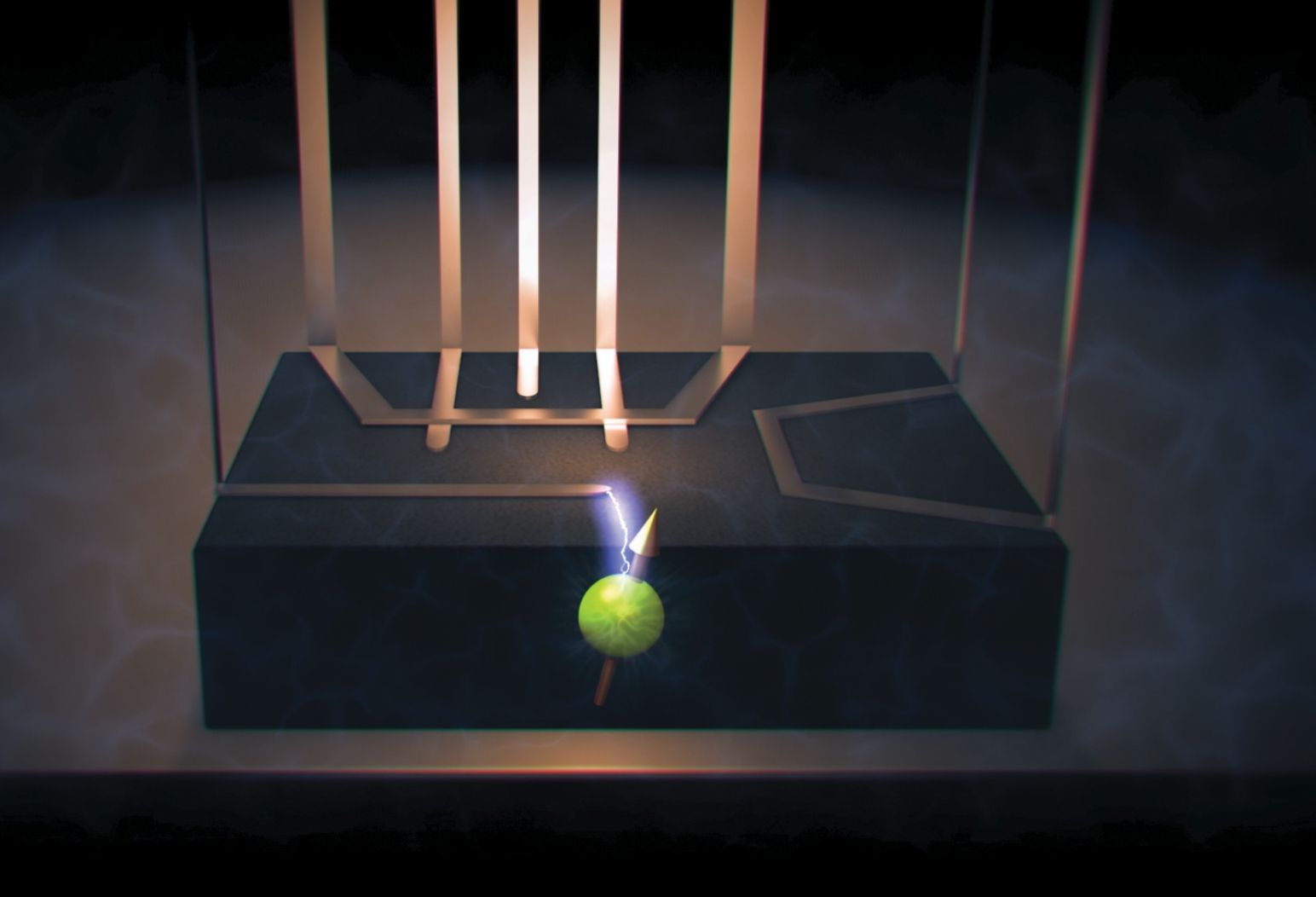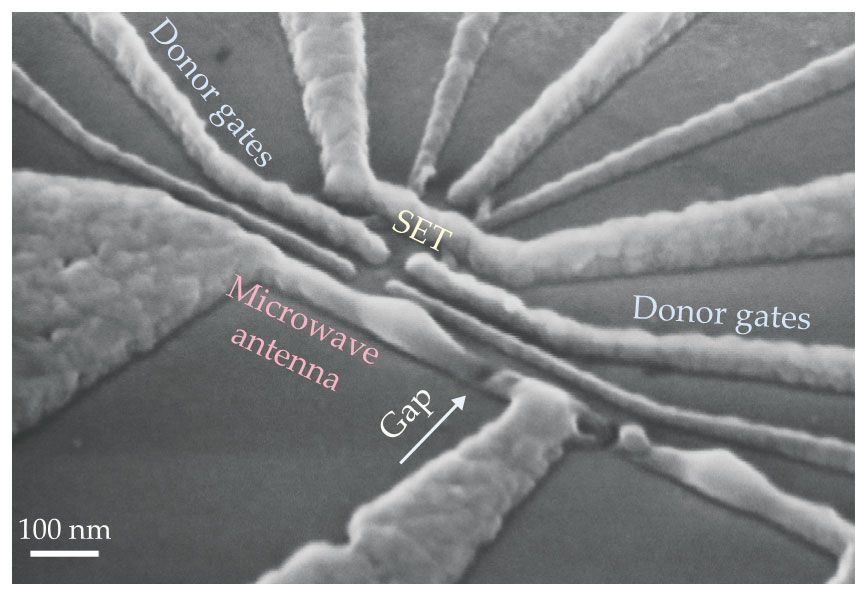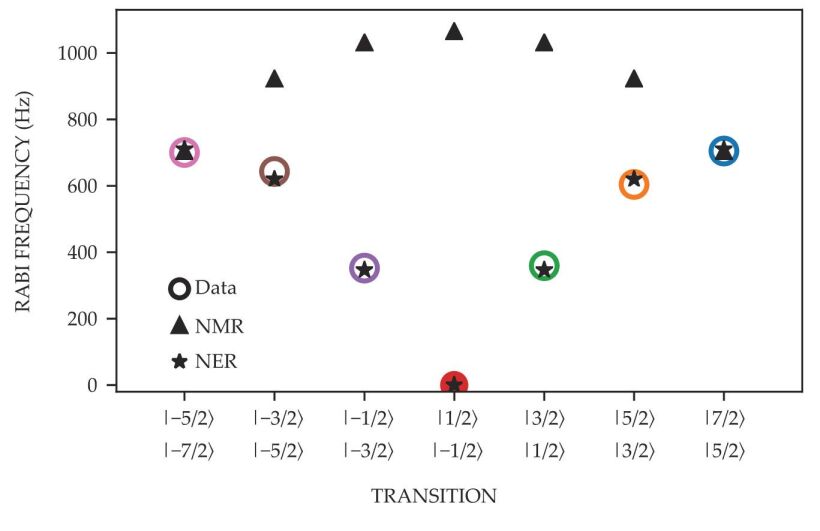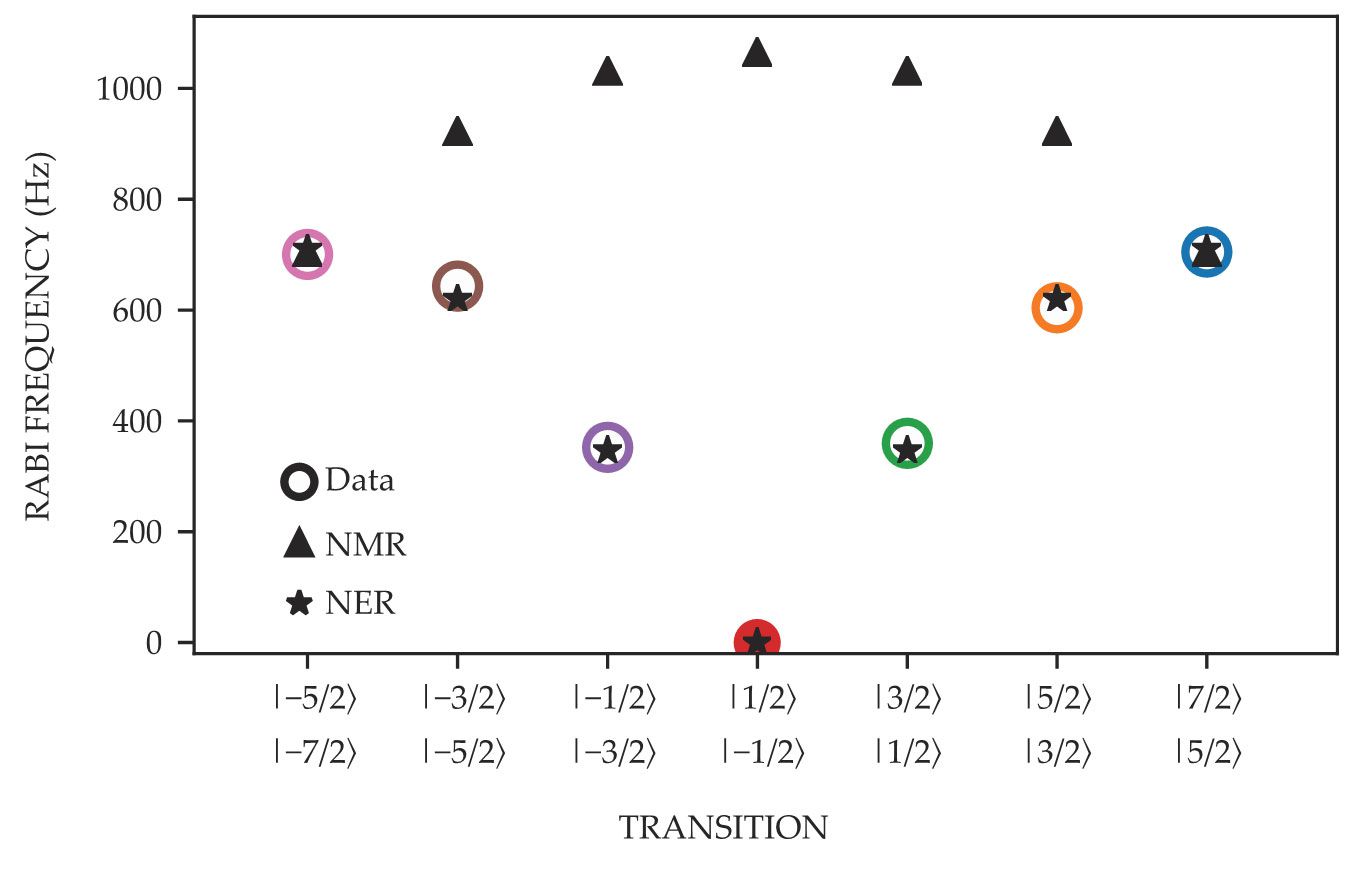Localized electric field manipulates a nuclear spin
DOI: 10.1063/PT.3.4468
One promising approach for quantum information processing involves embedding tightly spaced arrays of identical atomic nuclei in a silicon substrate. In that design, each nucleus’s spin serves as a quantum bit, or qubit. The qubit’s spin, which can be set to different states, is used to store and process information. However, before spin-based devices can be scaled up for practical use, quantum engineers need to be able to control a single nuclear spin in silicon without affecting adjacent spins.
In principle, NMR could do the job. Radio-frequency (RF) magnetic field pulses can excite and control nuclear spins that are polarized in a static magnetic field. Because of the pulses’ wide spatial extent, however, they tend to influence adjacent spins, which renders NMR impractical for manipulating individual spins in a collection of identical atoms. Ideally, a method for controlling individual nuclear spins would match the ease of exciting individual electron spins in a row of semiconductor quantum dots, in which each dot is equipped with a separate electrode. Adapting that approach for nuclear spins offers a potential advantage because nuclear spins have longer coherence times than electron spins and can be measured with minimal readout error.
Electric fields, rather than magnetic ones, provide an intriguing possibility for nuclear spin control. The fields can be efficiently routed and tightly confined in complex nanoscale devices. Indeed, highly focused electric fields make possible the sophisticated interconnections found in modern silicon computer chips.
Now researchers in Andrea Morello’s lab at the University of New South Wales in Australia have demonstrated electrical control over nuclear spin.
1
The researchers developed a technique for controlling the spin of a single atom embedded in a silicon chip, illustrated in figure
Figure 1.

In this artist’s impression of a nuclear electric resonance device, a sharp metallic antenna applies a strong oscillating electric field directly to an antimony atom (green) embedded in a silicon chip. Other metallic components include electrostatic gate connections and readout electrodes. (Image by Tony Melov/UNSW.)

Bulk efforts
The suggestion that electric fields could control nuclear spins dates to the 1960s. 2 Nico Bloembergen predicted that an external electric field can induce spins larger than ½ to transition from one energy level to another in crystals with low symmetry. Such nuclei can have nonspherical charge density distributions, or quadrupole moments, which couple to local electric field gradients. When placed in a crystalline environment without inversion symmetry, a time-varying external electric field should modulate that coupling and change the spin state.
Bloembergen’s efforts to demonstrate electrical control over spin saw partial success. His studies proved that static electric fields could shift spins between energy levels in a bulk crystal. 3 But those early experiments could not achieve dynamic coupling between an oscillating electric field and nuclear spins. Although they were “heroic experiments,” says Morello, the investigations were unable to create the requisite huge RF electric fields in bulk crystals.
Only recently did experiments cleanly demonstrate nuclear electric resonance (NER) in a bulk crystal. In 2013 Masaaki Ono and colleagues at Tohoku University, Japan, excited spins in gallium arsenide at their resonant frequency using an oscillating electric field. 4 Ono’s team proved the viability of using NER to manipulate spins in a bulk crystal.
Electrical accident
Coherent control over a single nuclear spin in a silicon device remained an unsolved problem. To investigate possible solutions for single spin control, Morello’s PhD student Serwan Asaad and postdoc Vincent Mourik used an antenna to magnetically probe an antimony-123 nucleus embedded in silicon. The researchers had originally set out to perform NMR on a single 123Sb nucleus, which has spin 7⁄2. They fabricated the device, shown in figure
Figure 2.

A scanning electron micrograph shows the metal-oxide-semiconductor device used in the experiment. An antimony donor atom is implanted in the silicon substrate. Electrostatic gates control the potential of the Sb atom embedded in the chip between the gates. The device contains a single-electron transistor (SET) for spin readout and a microwave antenna carrying an electric current that normally generates an oscillating magnetic field for performing NMR. (Adapted from ref.

Asaad realized that the high power had damaged the antenna and transformed it into an open circuit. As a result, the antenna was creating a strong electric field focused directly on the Sb atom. Conveniently, the device also included several tiny electrodes with which to control the potential of the atom. The researchers redesigned their experiments to apply an oscillating voltage to one of the electrodes and observed the same resonance spectrum as when applying power to the damaged antenna. Then, they calculated the rate at which transitions between different energy-dependent spin states should occur in response to either a magnetic or an electric field (see figure
Figure 3.

An RF field drives antimony-123 atom transitions between different nuclear spin states at different rates, the so-called Rabi frequency. The measured rates (colored circles) match theoretical predictions for transitions due to an electric field (NER, stars) but not those due to a magnetic field (NMR, triangles). (Adapted from ref.

Still, the result puzzled the researchers. The electric quadrupole moment—the nonspherical charge distribution of the nucleus—does not couple directly to an electric field, but to the field’s gradient. To understand the effect, Morello enlisted Andrew Baczewski of Sandia National Laboratories to perform ab initio calculations of the phenomenon. The simulations revealed that the applied electric field distorted the charge distributions in the bonds between the Sb atom and the Si atoms around it. Then the distortion of the charges produced a strongly nonuniform electric field around the Sb nucleus. That field provided the gradient that caused the nuclear spin transitions. The calculated effects match the experimental results.
Because electric fields decay rapidly with distance from the electrode and can easily be screened with other metallic structures, NER allows control that is localized enough to manipulate individual nuclei. The technique could help scale up a key component in quantum computing applications, according to Anthony Sigillito from Princeton University. The level of localized control demonstrated by Morello and coworkers could provide the precision needed to drive one qubit without affecting the other in a two-qubit gate, which is the fundamental building block of a scalable quantum computer. The new result opens the possibility of all-electrical driving of a donor qubit embedded in a silicon device.
References
1. S. Asaad et al., Nature 579, 205 (2020). https://doi.org/10.1038/s41586-020-2057-7
2. Science 133, 1363 (1961), abstract by N. Bloembergen. https://doi.org/10.1126/science.133.3461.1363
3. R. W. Dixon, N. Bloembergen, J. Chem. Phys. 41, 1739 (1964). https://doi.org/10.1063/1.1726153
4. M. Ono et al., Appl. Phys. Express 6, 033002 (2013). https://doi.org/10.7567/APEX.6.033002
